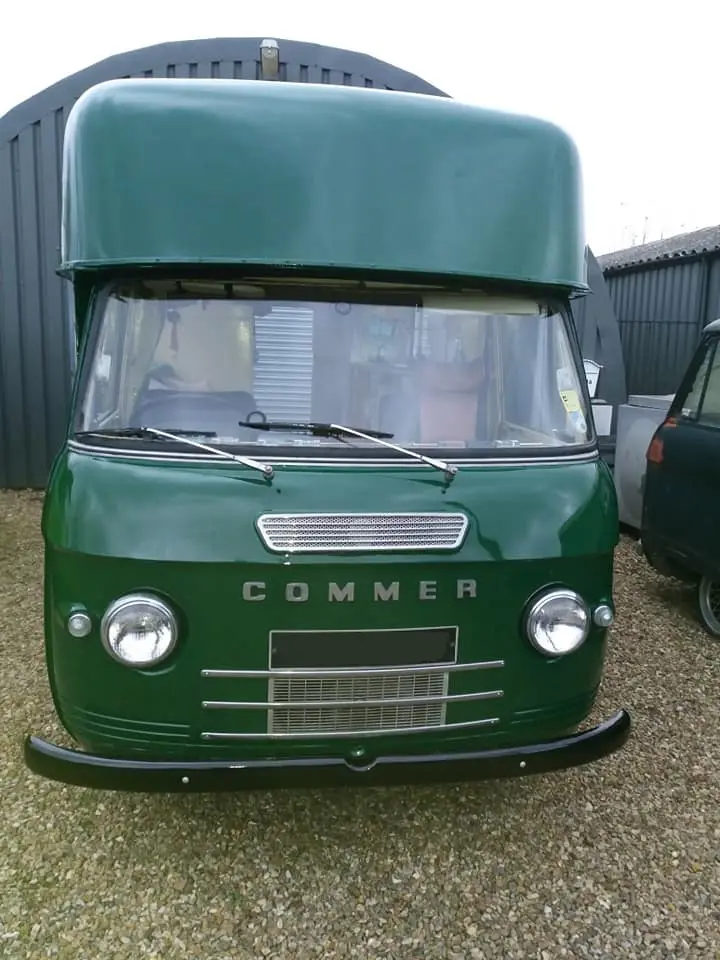MEET THE OWNER – CHRISTINE LYNNE BROWN AND HER COMMER HIGHWAYMAN
23 March 2023
The Commer was once part of the fabric of life in the UK – delivering milk, bread and groceries, attending to a telephone box vandalised by the local scooter boy gang or even starring in one of the best-remembered public information films of the 1970s:
Today, a 1963 model seems to belong to another world, one of newsagents with ‘Woodbines’ advertisements in the window and ABC cinemas. Christine Lynne Brown, its proud owner, says, “I have five vans in different states. Two are up and running minus a flat tyre, two were bought as an investment four years ago, and there is another rare coach-built version by Dandy.”

The original 1500 FC made its bow in 1960 as the replacement for the Commer Express and rivalled the new BMC J4, the Bedford CA, the Thames 400E and the Standard Atlas. Your friendly local dealer would extol the virtues of the forward-control body, the independent front suspension and the reliable 1,494cc engine from the Audax-series Hillman Minx.
The FC also boasted a narrower track at the front than at the rear to ensure manoeuvrability when making deliveries in town and a choice of no less than 16 body styles. These included campers, such as Christine’s example. As Practical Motorhome noted, the Bluebird caused a major stir with the first Austin and Morris based versions in the late 1950s:

“The price included a full oven cooker, 12V lighting, fresh water tank, and a toilet compartment with chemical toilet. Its development and popularity were down to a brace of big hitters: Bill Knott, owner and manager of Poole-based Bluebird Caravans, who understood the competitive advantages of mass production, and super salesman Peter Duff, the proprietor of Bluebird main dealer Croft Garages, in East London.”
The firm introduced the very popular Commer-based models in the early 1960s and Christine’s Highwayman is a prime example of Bluebird’s craftsmanship: “I got a bit of a surprise at the classic camper club national when the members voted her best golden oldie. We got a trophy!” Her camper is indeed a wonderful reminder why so many drivers thought it worth every penny of £973 17s. So, telephone the main distributor on Bishopsgate 3393 for a test drive.
In 1965 Ford launched the Transit but HM Government remained loyal to Commer; the following year, the GPO placed a £400,000 order for 600 ‘Post Office Telephones’ vans. The PB replaced the PA in 1967; the range became known as the ‘Spacevan’ seven years later. By August 1976, the line-up wore ‘Dodge’ badging as shared by almost all of Chrysler’s British-market commercial vehicles.
When Peugeot took over the American corporation’s European factories in 1979, they planned to end Spacevan production in 1981. However, the demands of British Telecom meant the final example left the factory as recently as 1983.
Forty years later, the Brown Commer looks as though it belongs in a black & white Edgar Wallace mystery, and Christine finds:
“She’s a beauty to drive - not as slow as you would expect! She runs on LPG gas and petrol with overdrive on 3rd and 4th. I leave her in gear and don’t use the handbrake as they get stuck on if left for a time - especially not when I’m driving.”
As for the public reaction - “People always have a story to tell of an old Commer”. And this quite understandable, for who could resist a van fitted with, to quote the brochure, a floor “covered in good quality linoleum.”
With Thanks To: Christine Lynne Brown
